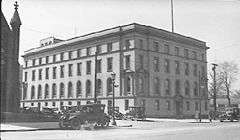Cleveland Clinic fire of 1929
 | |
| Time | 11:30 AM |
|---|---|
| Date | May 15, 1929 |
| Location | Cleveland Clinic |
| Coordinates | Coordinates: 41°30′08″N 81°37′03″W / 41.50236°N 81.61755°W |
| Deaths | 123 |
| Non-fatal injuries | 92 |
| Property damage | US$50,000 (US$683,850 in 2013 dollars) |
| Awards | US$45,000 |
The Cleveland Clinic fire was a major structure fire at Cleveland Clinic in Cleveland, Ohio on May 15, 1929. It started in the basement of the hospital and it was caused by nitrocellulose x-ray film that ignited when an exposed light bulb was too close to the film.[1] The fire generated poisonous gas and two separate explosions. The fire claimed 123 lives, including one of the founders, Dr. John Phillips.[2][3] Policeman Ernest Staab was killed by the gas while rescuing 21 victims.[2]
Disaster
The Cleveland Clinic is a non-profit Ohio corporation, founded in 1921 by four physicians. Late in the morning of May 15, 1929, an exposed light bulb too close to some nitrocellulose x-ray film ignited the film. The burning nitrocellulose film quickly produced a significant amount of poisonous gas, causing victims to suffocate, the faces of the victims turning yellowish brown within minutes.[2] Further complicating fire-fighting, nitrocellulose continues to burn even while immersed in water, and fighting the film-fueled fire simply caused more poisonous smoke to accumulate, raising the death toll.[4]
A first explosion came at a few seconds past 11:30AM; a clock on the third floor balcony stopped at that time. After the hollow center of the building was filled with poisonous gas, a second explosion shattered the skylight and sent the vapors into every corner of the clinic. Many of the building occupants succumbed to the poisons.[2]
Aftermath
Despite the heavy loss of life, firemen estimated the property damage at only $50,000 ($683,850 in 2013 dollars).[5]
According to investigators, the clinic was not at fault for the fire. Nonetheless, the disaster was responsible for influencing significant changes to fire-fighting techniques. The city of Cleveland issued gas masks to its fire departments and proposed a city ambulance service.[1] Nationally, the disaster prompted medical facilities to establish standards for the storage of nitrocellulose film and other hazardous materials.[1]
References
- 1 2 3 "Cleveland Clinic Fire". Retrieved 2009-06-16.
- 1 2 3 4 "Cleveland, OH Clinic Explosion and Fire, May 1929". Retrieved 2009-06-16.
- ↑ "Encyclopedia of Cleveland History: CLEVELAND CLINIC DISASTER". Retrieved 2011-05-07.
- ↑ Health and Safety Executive leaflet/cellulose.pdf
- ↑ http://www.bls.gov/data/inflation_calculator.htm BLS Inflation Calculator